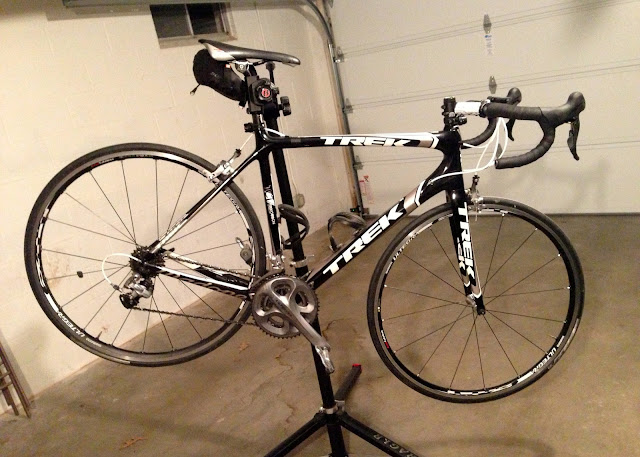Okay, enough of the mushy stuff. For me, the real draw of the Domane is that it's tailor made for riders like myself - recreational endurance riders who love to tackle the club ride, a race or two and an occasional century endeavor here ore there, while remaining as comfortable and capable as possible. There are many bikes that fit into the Plush or Endurance category, and I believe that list is only going to grow.
Getting the Bike
My local bike shop, the Trek Bicycle Store of Omaha, just so happened to select the Trek Domane 5.2 as it's rental bike of the season, so I was able to call in a few favors to take one out to knock around (thanks guys). I also procured a Bontrager Race X Lite TLR wheelset for the outing. I'll be reviewing a different Bontrager TLR set in the coming weeks, so I'll hold on complete details until then.
Update (7/17/13): here is my review of the Bontrager Race Lite TLR Wheelset and R3 TLR Tire
The Setup
My 2011 Madone is setup very similarly to the 2013 Domane, so switching bikes was not overly difficult. I moved my computer and integrated speed/cadence sensor without issue, and also swapped my entire seat mast and saddle together to avoid breaking in a new stock saddle. The Ultegra drive train and shifters were the same, so no issues there either. The Race X Lite TLR wheels were an upgrade over my Ultegra tubeless set, so in hindsight I should have ridden my own to keep things equal.
Truly, the only visible differences between the Madone and Domane are the Domane's IsoSpeed Decoupler (seat tube separate from the rest of the frame), a bit taller head tube, and the swept-forward fork position. Other than that and a more squared top tube, the bikes appear very similar.
 |
| 2013 Trek Domane 5.2 |
 |
| 2011 Trek Madone 5.2 |
Tech Stuff
I have poured over the tech specs of the bike, but rather than bore and most likely confuse most with an inaccurate rendition of what really makes the Domane different, just watch this quick explanation from Trek, and read on for what the bike actually felt like on the road. If you want the Cliff Notes version, the frame is designed to lessen road vibrations that cause fatigue and lost power.
Out on the Bike
I only had time to ride the Domane once, but I made that one time count. The 60 mile route consisted of rolling hills, fast paces and surfaces that ranged from smooth to questionable. Those fast paces put me close to the red line multiple times and probably had something to do with the painful leg cramps that crept up on me with about 5 mile to go. New bike or not, it was a tough day.
The Good
As advertised, the Domane works like magic when it comes to rough surfaces and unexpected road blemishes - things that really send stress straight through my Madone frame and into my back. Bumps were dampened nearly to the point where I was able to focus less on the road and more on staying with the group.
Overall, I just felt less stress at the end of the ride. The shorter top tube and taller head tube put me in a bit more upright position than my Madone, which I will credit to saving some pain in my neck, shoulder and back. All good things on longer rides.
The Bad
As with any test ride, and any new bike in general for that matter, there are kinks to be worked out. The particular Domane I rode was having some trouble with chain/derailleur noise. I had a mechanic give it an adjustment, but the noise came back a short while later. New cables that need a good stretch are most likely to blame.
With the Domane 5.2 itself however, there was little to find at fault, other than the paint choice. While the color may seem inconsequential for most, I truly feel that for a $3,679 bike, the red/white scheme seems tired, if not a bit overdone. The same can be said for the entire line until you hit the Domane 6.9, which will set you back almost $7,000 and get you a faster-looking red/black/white layup.
The Verdict
After giving this bike about all I had, I can honestly say I enjoyed riding it quite a bit. I am not going to hop online and put my Madone up for sale any time soon, but when the time comes, the Domane does seem like a great option for me. I'm not getting any younger (neither are you) and there is definitely something to be said about reducing the amount of wear and tear on your back, and your body in general, while still being able to keep up with the group - at least for most of the ride.
 |
| Peace |
 |
| 2013 Trek Domane 5.2 |
 |
| IsoSpeed Decoupler |
Review: Trek Domane
Written by: Paul Haskell
2013 Trek Domane 5.2
Date published: 05/23/2013
4.0 / 5 stars


No comments :
Post a Comment